Tabasco Style Fermented Hot Sauce
August 21, 2014 | Updated June 06, 2022
As an Amazon Associate I earn from qualifying purchases.
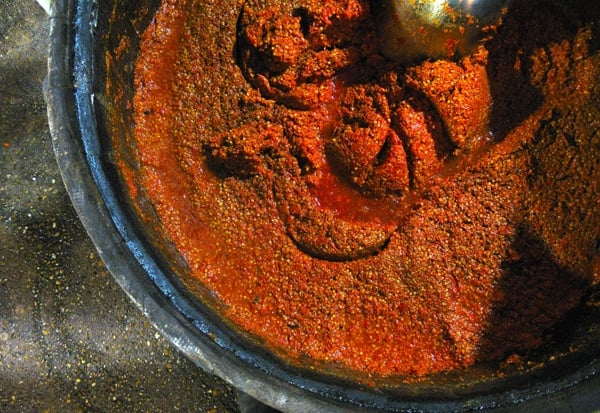
I am a Tabasco man, always have been. Sure, I love lots of hot sauces, but for me the alpha and omega of pepper sauce is Tabasco. What I didn’t know until I visited their plant was that it is a fermented hot sauce.
This slow fermentation makes sauces like Tabasco something more than just heat and vinegar, something more refined and mellow. I had no idea what that something was until I got a chance to visit Avery Island, Louisiana, and meet the McIlhenny family face to face.
Touring the plant, I was shocked to learn that the recipe for Tabasco is not some closely guarded secret. They’ll gladly tell anyone who asks what it is: Tabasco peppers, 2 1/2 percent salt, vinegar… and time. Lots of time. Winemaker-style time. Tony Simmons, the company’s CEO, walked me through it.
The Tabasco chiles are chopped up, mixed with salt mined right from the island itself, then poured into old oak barrels to ferment in a barn for up to five years, although most of the mash is fermented only (!) three years.
They then mix the mash with distilled vinegar (they used to use white wine vinegar) and let this pickle for a month, mixing all the way. Finally, they strain out the pulp and seeds and bottle the sauce.
I was fascinated by this. Aged in oak? For three years?! Damn. Gauntlet thrown. One I will gladly pick up.
Two years later, here’s how it went.
I decided to not even try to replicate Tabasco Sauce exactly, because why would I want to? Even if I succeeded, I can buy the stuff easier at the supermarket. I’d use the method, with different chiles, to make my own fermented hot sauce. Rather, two sauces: One red, one green.
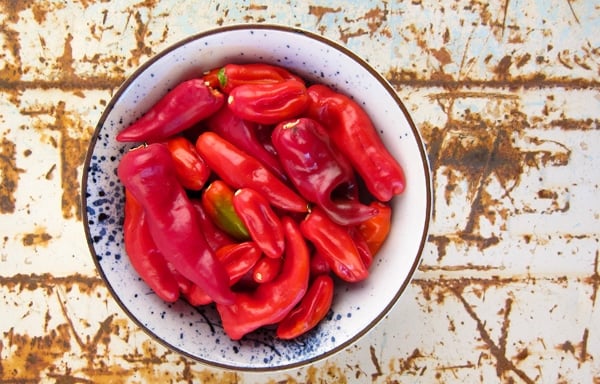
I grew a lot of chiles that year, so I used an eclectic mix of serranos, Tabascos, ripe padron chiles, and a few Thai chiles tossed in for good measure. Yes, I know doing this makes this sauce unrepeatable, but so be it. No vintage of a wine is exactly repeatable either, and since fermented hot sauce keeps almost as long as wine, it’d be fun to play with annual vintages.
I waited until late September 2012 to harvest all my chiles, and I grabbed both the red and green.
I stemmed them all and chopped them roughly, then tossed them in a food processor with that critical 2 1/2 percent salt — this is enough to protect the chiles from bad bacteria but not enough to prevent fermentation by the good bugs.
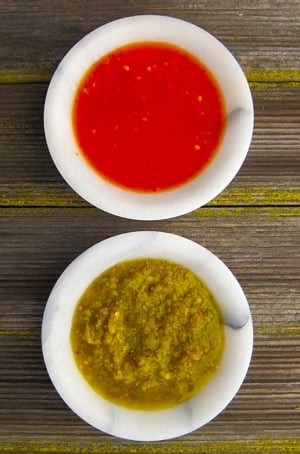
Into quart Mason jars they all went. Within a day they were fermenting, with an acrid, slightly yeasty smell that was something like a cross between Mace and a loaf of bread. Not that unpleasant, actually. I stirred the mash every day and let it breathe. After about 10 days things settled down, so I moved the jars into my salami fridge, which is a cool 55°F. But before I did that, I grabbed some toasted oak cubes I had from winemaking and tossed them in. Instant oak barrel!
And then I forgot about my hot sauce. For two full years. OK, that’s not totally true. Every few months or so I’d check on them, and once in a while a film of mold would grow on the surface; this happened three times. I just picked it off and called it good. After all, we’re dealing with chiles and salt here, both of which are pretty inhospitable ingredients to any truly bad wee beasties.
Finally, earlier this year I decided to make my sauce. I stared at that awesomely fermented mash, which was at once mellow and smooth yet muy picante, if such a thing can exist. I just couldn’t discard it. So I pureed it even smoother and added a little xanthan gum to stabilize it.
The result is a lovely hot sauce. Tangy from the fermentation, hot but not overbearing (a result of the mix of chiles I used), vinegary and a bit salty. It’s not Tabasco. It’s something different. Something… better? Perish the thought.
Fermented, Tabasco-Style Hot Sauce
Ingredients
- 3 1/3 pounds chile peppers, about 1.5 kilos
- 1 ounce kosher salt, about 37 grams
- 2 cups water
- 3 ounces oak cubes
- 4 cups white wine vinegar
- 1 teaspoon xanthan gum (optional)
Instructions
- Roughly chop the chiles and compost the stems. Blitz the chiles in a food processor or blender with the salt and water until you get a rough paste or slurry, depending on how much moisture there is in the peppers themselves. I keep the seeds in the chiles, but if you want a milder sauce, remove them.
- Put the mash into quart mason jars and cap them loosely. "Burp" the caps at least once a day to let out escaping gases and let air in. The chiles will ferment like this for at least a week, and sometimes up to 3 weeks. When the chiles settle down, add the oak cubes, distributing them evenly throughout the jars. Tighten the lids and store the jars in a cool, dark place. I kept mine in my salami fridge, which is 55°F. A basement is fine, as would a fridge. Tabasco keeps their mash barrels at ambient temperatures, which in Louisiana can top 100°F. I am working on a batch fermented this way now, and I see no reason it won't work. Don't let the mash freeze, however.
- Keep the mash like this no less than 3 months, and up to 2 years. When you are ready to finish the sauce, mix the mash with the vinegar.
- You now have two choices: You can do what Tabasco does and return the mix to the jars, shake them every day for a month and then strain out the pulp and seeds. Or, do what I do and keep all that pulp, which will give the sauce body and thickness. If you choose my method, you will need to really blend the sauce and stabilize it -- otherwise the sauce will eventually separate and will need to be shaken up before each use. To do so, dissolve the xanthan gum in 2 tablespoons of water and add it to the blender. Blend for a solid minute. Let the sauce rest for 1 hour before bottling so any trapped air in sauce (from the blending process) can escape. Bottle and store. The sauce will keep for a year or more.
Notes
Nutrition information is automatically calculated, so should only be used as an approximation.
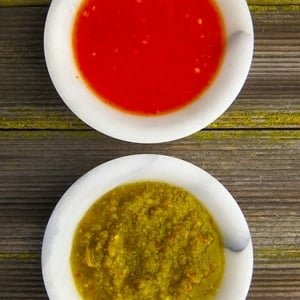



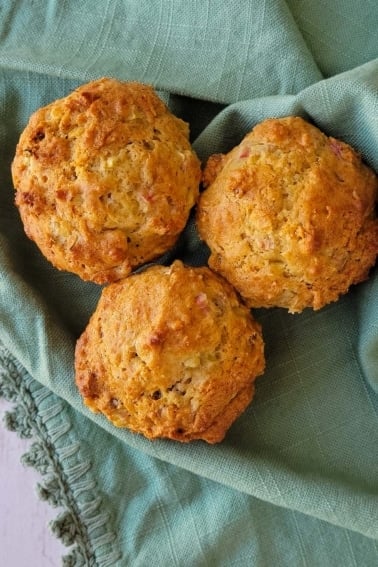
Hi Pete,
I have bucket loads of Thai chillies I’m going to use for your tobasco recipe. I’m a little excited! Maybe I could add some other Thai flavours. Any ideas what might work? Thanks for the recipe ?
You can try using pectin which is a thickening agent in jams.
I just pulled a mason jar of this stuff dated 8/23/2014 out of the fermentation fridge, made with Tabasco peppers and bourbon soaked oak cubes. Thank you very much for the inspiration, this recipe is the bomb.
Is this shelf stable once opened, or does it require refridgeration?
Jim: It’s shelf stable.
So I tried this in a small batch and my fermentation turned a slight brown color. No, I did not add wood to the process. What did I do wrong, or is this normal and I can salvage what I have?
Brad: It’s oxidation. Should be OK to eat. Try to keep more air off the mash next time.
Hank! Love the recipe, thank you! I want to add a small amount of garlic and onion to my 30 pound batch of peppers. Is there anything to worry about when adding these two extra inhredients in? I’d like to be able to leave it out at room temp for about 4 weeks.
Thank you!!
Mariela
Also, based on your reply to Anna, I will not add vinegar to the first batch which has too much salt. Eventhough it has been fermenting for 3 months, shall I still add more chili and ferment for another 3 months?
Earthmother: Can’t hurt. Fermentation this way is pretty forgiving…
Hi Hank. Thanks again for sharing this great recipe. I am following your recipe using New Mexican Hatch Green Chili, Garlic and Onion. I made the mash in two batches. The first batch, I realized after I jarred them, that I used a higher concentration of salt than you recommended. Still, I am following through to see what results.
The second batch, I properly calculated the percent of salt. I found that the jars began to overflow with a liquid. A lot of the liquid leaked out pushing through the loose lids. I then transferred some of this batch into two additional jars. The liquid level didn’t seem to return. Do you think loosing the amount of liquid that I did will affect the fermentation process?
Now, both batches are in the phase where I am adding the white wine vinegar. I did so, leaving in the cubes as there were no instructions to remove them at this point. I am very excited to enjoy the finished product!
Great advice and great insight from Tabasco. Like you I’m a Tabasco aficionado(no other sauce comes close, not very keen on cooked sauces at all) and experimented with a fermented sauce from my UK home grown chilli harvest last year. This year I’m making more, refining the technique having found your site and laying down batches so that I can eventually have a 3 year rolling stock.
The big addition this year is the oak cubes. I’ve sourced some from barrels used in whiskey ageing, that were originally used for sherry and bourbon storage! They have a sweet and powerful aroma and have just been added to this year’s ferment.
I added too much salt…how do I fix it now?
Anna: To the mash? Only way is to add more ground chiles.
Thanks! Looks great!! I’m going to make this today. What type of oak do you use? American? What toast?
Thanks
i can’t find my favorite sauce anymore so i will try this to replicate it. It’s Picka Peppa from Jamaica. it’s hotter than Tabasco and a little sweet. it has cane vinegar in it and i believe that’s the key…i hope. thanks
Just finished jarring my peppers and placing them on the shelf! Thanks for the recipe, looking forward to it!
Wow, great stuff. The addition of oak cubes is a great idea. I’m inspired to try this too!
so far this sounds like the best recipe l have researched. Makin it now, but l will have to make a quick recipe to tide me over. Do you have a like a 2-3 week recipe? I made a quick one last year and it was damn good and lasted for almost a year, am interested if you do have an idea for a quick one.
This sounds wonderful. Question: Can the final product be stored on a shelf?
Earthmother: Yes, but I prefer a cooler place like a basement.
Hi great site, I think you should check out https://phickle.com it’s amazing what doesn’t need to be used when fermenting. We regularly pickle all sorts of hot peppers that we prepare whole, in chutneys or in a variety of dips that get consumed as fast as we can make them! I really like the oak chip idea sounds delicious!
Most people think hot sauces are made by cooking the peppers in some way. Few people know about fermenting peppers to make a hot sauce. Yet, in my opinion, fermenting peppers is the way to go! And the taste does mellow out and even completely change as its refrigerated over the course of a year. I also beleive that the vitamin C content of the peppers is preserved during the fermentation process. In comparison, cooking the peppers breaks down the vitamin C. So, a cooked hot sauce won’t have a significant vitamin C content. I once made a fermented hot sauce from habanero peppers and at first it was so hot that I could only tolerate a smear of it on my food. After a couple months, the heat didn’t bother me and I started to crave the flavor of the sauce and would eat it by the spoonfull. A year or so later after I have finally finished it off, I think I went through withdrawals for a couple months. Ever since, I’ve been trying desperately to grow my own habaneros since I just can’t find the quantities I need for sale where I live. BTW: poblanos make an excellent fermented hot sauce by themselves.
I made several batches of tabasco sauce. I grow the tabasco pepper. 2 plants are all you need. This years finished product will have been aged 7 and 10 months. I haven’t used oak and everyone that has tried it say the flavor is superior to tabasco brand, I may try the oak. I do use a combination of white wine vinegar, white balsamic and white vinegar.
LOVE LOVE LOVE this!!! I can’t ever even grow chillies properly, they always end up getting black around the stems then it goes onto the chillies themselves :0( any tips? Anyhoo I’ve just found this site and it looks great, I look forward to trawling through :0)